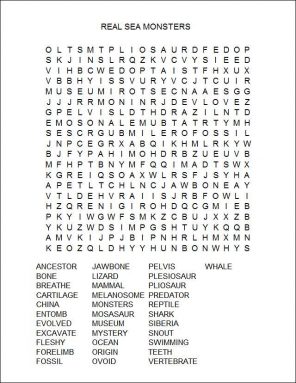The real sea monsters
When dinosaurs ruled on land, these reptiles prowled the seas
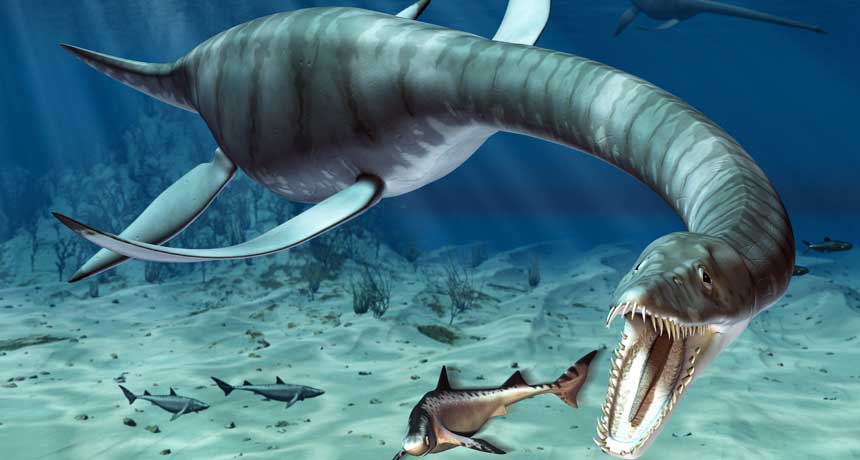
Plesiosaurs inhabited the seas from around 200 million to 65 million years ago. They were not dinosaurs, despite living at the same time as dinos. It is thought that plesiosaurs fed mainly on fish, breathed air and laid their eggs on beaches. The largest of these sea monsters reached 15 meters (49 feet) in length.
Roger Harris / Science Source
By Sid Perkins
Second of two parts
For millions of years, reptiles dominated the Earth. Many that dwelled on land were dinosaurs. But no dinos swam in the seas. The oceans had their own cadre of reptiles. Many were top predators, the sharks and killer whales of their time. And they would have made the oceans very dangerous.
Some of these marine reptiles were shaped like dolphins and probably could swim fast. Some were as large and as long as a school bus. But they lacked the distinctive hip structure that only dinos had.
A dinosaur had distinctive holes in its pelvis where its thighbones were attached, notes Sterling Nesbitt. He’s a vertebrate paleontologist at Virginia Tech in Blacksburg. Marine reptiles of the same time period lacked such holes.
About 252 million years ago, there was a mass extinction. At that time, huge volcanoes erupted in what is now Siberia. The ocean’s chemistry changed as well. As a result, large numbers of animals, plants and other species died out. Overall, about 90 percent of ocean species and 70 percent species on land disappeared. After the devastated ecosystems recovered, the few species that survived evolved to better fit in with the new environmental conditions.
With so many ocean species gone, some land creatures tried an aquatic lifestyle — and succeeded. These animals evolved to become ichthyosaurs (IK-thee-oh-saurs). Much later, after additional mass extinctions, other land-dwelling reptiles took to the seas. Their descendants evolved to become plesiosaurs, pliosaurs and mosasaurs.
People have been unearthing fossils of such sea creatures for hundreds of years. But scientists are still finding new species and discovering new information on what these animals looked like and how they lived.
Fish-lizards of the sea
Ichthyosaurs were among the earliest lizards to take to the seas. Their name even means “fish-lizard” in Greek. On the whole, ichthyosaurs were very successful. So far, paleontologists have discovered and named more than 100 different species of them, notes Benjamin Moon. He’s a vertebrate paleontologist at the University of Bristol in England.
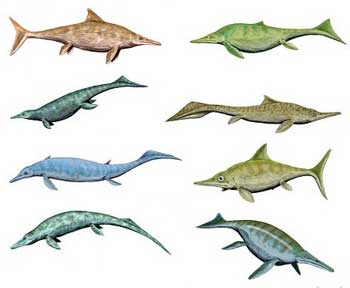
Species from this group lived from about 248 million years ago to about 95 million years ago. Their fossils have been found worldwide. None of these came from rocks that started out as sediments from lakes or rivers, he notes. So ichthyosaurs all must have been ocean dwellers. Some of these aquatic reptiles were no more than 80 centimeters (about 31 inches) long. Others spanned a whopping 22 meters (72 feet). Some were very streamlined, like today’s dolphins. Others had more lizard-like proportions.
Some ichthyosaurs lived and foraged in coastal waters at the edge of continents. But others apparently swam in the open ocean, far from land. They even gave birth to live young at sea, like today’s whales and porpoises do. This is an example of convergent evolution, or the development of similar features in totally unrelated lineages. These similarities likely evolved from having to adapt to similar environments or places within an ecosystem.
Paleontologists had long suspected that some ichthyosaurs dove deep to find prey, like modern-day sperm whales. One of these animals was Ophthalmosaurus (Op-THAHL-moe-saur-us). With eyes up to 10 centimeters (4 inches) across, it takes its name — “eye lizard” — from the Greek. These 6-meter (nearly 20-foot) long creatures must have been chasing prey into very deep, dark waters, some scientists believe. Others have suggested those big eyes would have let the lizards hunt at night.
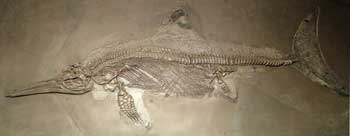
A recent study of some amazingly preserved fossils may help put an end to the debate. Scientists unearthed the fossils from rocks that are between 190 million and 196 million years old. Most fossils preserve just bone and other hard tissue. But these fossils included soft tissues that are probably skin.
Peppering the inside of that apparent skin were tiny blob-like structures. These measured between 500 and 800 nanometers long. That’s the same size as the pigment-carrying structures in skin cells and feathers of today’s mammals and birds, notes Johan Lindgren. He’s a vertebrate paleontologist at Lund University in Sweden. He and his colleagues now propose that the tiny blobs in this reptile are the remains of its pigment-carrying structures. Lindgren’s team described the findings in the February 27, 2014 issue of Nature.
The blobs were not flat, but ovoid. So the animal was probably black or dark brown, says Lindgren. His reasoning: That’s the color provided by ovoid melanosomes — the pigmented structure in cells — of modern-day animals. Perfectly round, or spherical, melanosomes usually carry a red or yellow color.
A deep-diving animal with a dark color over its entire body would be well camouflaged, Lindgren says. That would make it relatively easy to sneak up on prey. Today’s sperm whales, which hunt giant squid in deep waters, are dark gray all over, he notes. So, it’s very possible that the ancient ichthyosaur that he and his team studied was a deep-diver too.
Long-necked beasts
About 205 million years ago, a new type of marine reptile appeared in the seas. Scientists call them plesiosaurs (PLEEZ-see-oh-saurs), from the Greek words for “near to lizards.” The earliest of these resembled lizards, their presumed ancestors. But over time, the animals evolved to look very different.
Plesiosaurs typically had broad bodies, flippers and short tails. The most distinctive species also had long necks that made the animal look like a snake threaded through a turtle’s shell. And while most plesiosaurs had long necks, some had really long necks, notes Michael Everhart. He’s a vertebrate paleontologist at Fort Hays State University in Hays, Kansas.
These super-long-necked plesiosaurs belonged to a group called elasmosaurs (Ee-LAZ-moe-saurs). Their necks were so long that some of the first scientists to assemble their fossils couldn’t believe it, says Everhart. They mixed up the long neck and short tail, mistakenly putting the skull at the wrong end.
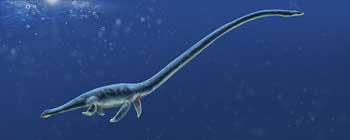
Recently, Everhart and his team took another look at fossils from a plesiosaur called Elasmosaurus platyurus. Dug up in Kansas during the late 1860s, these rocks were soon shipped East to a museum in Philadelphia. They’ve been there ever since.
The fossils that Everhart’s group surveyed are amazingly complete. They include a skull, which often is missing from plesiosaur specimens. Few skulls have survived because they are so delicate and relatively small — not much bigger around than the creature’s neck. Scientists have estimated that the creature was about 13 meters (42 feet) long when it was alive. And 7 meters (23 feet) of that length was nothing but neck!
Many teams have studied this specimen since it was first unearthed almost 150 years ago. But scientists are still in debates over the animal’s anatomy. For instance, they can’t decide how many neck bones it had.
When Everhart and his teammates looked at all the fossil pieces sitting on the museum’s shelves, they found an additional bone stored separately on a shelf nearby. It probably had been excavated at the same time. But it hadn’t been labelled by the people who dug it up. Still, it seemed to have come from the right type of rock and it had the same color and texture as the other fossils. It also was the right size and shape to be a part of a plesiosaur neck. So the researchers thought that perhaps the ancient jigsaw puzzle hadn’t been put together correctly. After further study, they proposed that this bone was indeed a new addition to the plesiosaur fossil.
If that’s right, then the beast had a whopping 72 bones in its neck. For comparison, almost all mammals — from mice to humans and giraffes — have only seven. Only one vertebrate now known had more neck bones than Elasmosaurus, says Everhart. That creature was also an elasmosaur. Its name is Albertonectes vanderveldei. It lived about 70 million years ago. Overall, it was slightly shorter than Elasmosaurus, but it had 76 neck bones.
Near the other extreme of neck proportions were marine reptiles called pliosaurs (PLY-oh-saurs). They emerged at around the same time as plesiosaurs. Even though they were related, evolution shaped them differently. Both groups both had broad, streamlined bodies. But pliosaurs had relatively short necks and massive heads. Because pliosaurs had large pointy teeth, scientists suggest they ate only meat. Their diet probably included fish, squid and other marine reptiles.
Similar shapes
Some 98 million years ago a fourth major group of marine reptiles emerged. The first fossils of these creatures were unearthed near the Meuse River in the Netherlands. The Latin name for that river is “Mosa,” hence the animals’ name: mosasaurs (MOE-sah-saurs). Their fossils have been found on every continent, so these animals had a global range. They died out about 66 million years ago, at the same time as the dinosaurs.
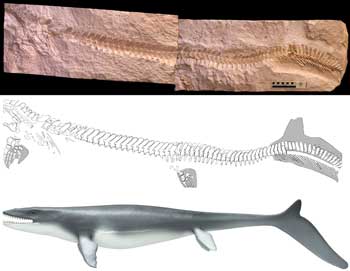
Mosasaurs started out small. One early species measured just 1 meter (3.3 feet) long, says Michael Polcyn. He’s a vertebrate paleontologist at Southern Methodist University in Dallas, Texas. But over time, he notes, some species became huge. The biggest spanned about 17 meters (56 feet).
Like pliosaurs, mosasaurs were top predators. So bigger species would have tackled really big prey. Fossils preserve some remnants of their last meals. That evidence shows that mosasaurs ate fish, squid, turtles, plesiosaurs and even other mosasaurs.
Fossils show that in some mosasaurs, the long tail makes an unusual turn downward, says Lindgren. That kink has long been a mystery. But in 2008, paleontologists found some very well-preserved mosasaur fossils that, for the first time, included soft tissue. Such ancient remains are giving scientists an idea of what the creature’s tail actually looked like. Lindgren and his team described the fossils in September 10, 2013 in Nature Communications.
Right above the point where the tail takes a turn downward, there’s an impression of a fleshy fin. That fin appears to have been covered with tiny scales. That’s expected for a reptile. But the shape of the fin is amazingly similar to the fleshy fins of some of today’s sharks. It’s also similar to the shape of the fins of some ichthyosaurs.
This is another example of convergent evolution. Mosasaurs, ichthyosaurs and sharks all lived in water and sometimes had to swim long distances. So, it was best for them to be as energy efficient as possible. For some species, that included being streamlined and having a long, crescent-shaped tail.
Where baby sea monsters come from
Scientists have long wondered how and where mosasaurs raised their young. Unlike with ichthyosaurs, few fetal remains have been found inside the bodies of adult mosasaurs, notes Daniel Field. He’s a vertebrate paleontologist at Yale University in New Haven, Conn. So perhaps adult mosasaurs laid eggs on land, like their distant, land-dwelling ancestors had. Or maybe they swam upstream into rivers, where young mosasaurs might have been better protected from ocean-going predators. There hasn’t been any strong evidence to support either notion, though, says Field.
In fact, there had been plenty of reason to think mosasaurs gave birth to their young at sea.
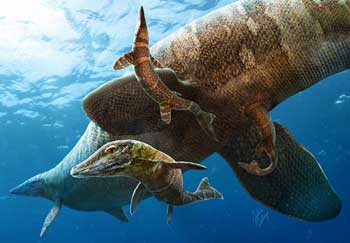
For one thing, he notes that mosasaurs were well-adapted to life at sea — not to life on land. Indeed, having a tail that bent downward at the end, rather than stretching out straight, would have made getting around on land pretty tough. Moreover, the pelvis in most mosasaurs wasn’t attached to the spinal column. That would have made it tough for the creatures to support their own weight or move efficiently when out of the water. But all these facts provided only circumstantial evidence for reproducing at sea, says Field. It was not strong proof, however.
Then, about a decade ago, researchers found fossils of young mosasaurs that had been buried in sediments far out at sea. The surface of those fossils showed signs of being eaten away by acid. It was as if the animals had been swallowed and partially digested. The bones had been either pooped out or thrown up. Then they had sunk and been preserved. That means that the young mosasaurs could have been eaten near shore and their remains carried out to sea inside whatever creature had eaten them.
But now, Field and his team have found fossils of young mosasaurs that hadn’t been etched by stomach acid. These fossils were entombed in rocks that had started out as seafloor sediment far from shore. So it’s likely these young mosasaurs had died at sea, says Field. It also seems likely they had been born there, he adds.
The fossils that Field’s team studied are tiny bits of jawbone. They include a few teeth. And the researchers didn’t go far to find them: They were stored at Yale’s museum, where they’d been sitting since soon after their discovery in the late 1800s. (This is yet another example of why collecting fossils, and keeping them for future study, is important.)
When paleontologists had first looked at the fossils, they assumed these were only bits from ancient seabirds. So they tucked away the bits in museum drawers. But new analyses show that the teeth were fastened into the jaws by a type of bony tissue that only mosasaurs had. Field and his colleagues described this discovery April 10 in Palaeontology.
After comparing the size of the tiny fossils with those of 3-meter-long adults presumed to be from the same species, the researchers now estimate the young mosasaurs were about 66 centimeters (26 inches) long.
“These are the first fossils from mosasaurs in this age bracket,” Field notes. They are also strong evidence for the notion that mosasaurs lived their entire lives in the open ocean.
The missing origin story
Unlike sharks and other fish, ancient marine reptiles were air breathers, like whales. That’s because ichthyosaurs, mosasaurs and other ocean-going reptiles had evolved from creatures that once lived on land.
For a long time, though, paleontologists had no idea of what the land-dwelling ancestors of these species might look like. That’s because there was a big gap in the fossil record before the first ichthyosaurs, says Moon in Bristol, England. That hole in time was millions of years long, he adds. It was so long that once the ichthyosaurs were discovered, even the earliest known individuals already were well adapted to life at sea.
Then, in 2011, a team unearthed an interesting fossil in eastern China. It was nearly complete and lacked only a part of its tail. The ribs and vertebrae had thick walls containing lots of bone. So the creature was probably an adult when it died, says Da-Yong Jiang. He’s a vertebrate paleontologist at Peking University in China. But most bones in the fossil’s forelimbs were small and widely separated. That’s a sign that the forelimbs were probably cartilage-filled flippers and not legs, he explains.
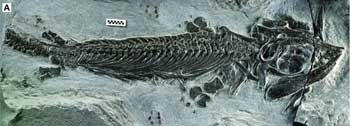
The hind limbs also were smaller than would be expected for something that lived on land. That would have been another adaptation for swimming. The limbs probably weren’t used for propulsion, Jiang says. Nevertheless, the reptile could probably get around on land, just as today’s seals and sea lions can.
When alive, the creature was probably about 40 centimeters (16 inches) long and weighed about 2 kilograms (4.4 pounds). It is now the smallest known ichthyosaur. Scientists named it Cartorhynchus lenticarpus (CAR-toe-RING-kuss LEN-tee-CAR-pus). That comes from the Greek words for “shortened snout” (another feature of this fossil) and the Latin words for “flexible wrist.”
This creature “is the closest thing we have to a terrestrial ancestor of ichthyosaurs,” says Valentin Fischer. He’s a vertebrate paleontologist at the University of Liège in Belgium. He was not part of Jiang’s team.
The new find also suggests that even earlier ancestors of ichthyosaurs might be discovered one day. Unearthing those species might help scientists solve the mystery of which land creatures gave rise to these sea monsters of our distant past.
Power Words
(for more about Power Words, click here)
anatomy The study of the organs and tissues of animals. Scientists who work in this field are known as anatomists.
camouflage Hiding people or objects from an enemy by making them appear to be part of the natural surroundings. Animals can also use camouflage patterns on their skin, hide or fur to hide from predators.
cartilage A type of strong connective tissue often found in joints, the nose and ear. In certain primitive fishes, such as sharks and rays, cartilage provides an internal structure — or skeleton — for their bodies.
continent (in geology) The huge land masses that sit upon tectonic plates. In modern times, there are six geologic continents: North America, South America, Eurasia, Africa, Australia and Antarctic.
convergent evolutionThe process by which animals from totally unrelated lineages evolve similar features as a result of having to adapt to similar environments or ecological niches. One example is how some species of ancient marine reptiles called ichthyosaurs and modern-day dolphins evolved to have remarkably similar shapes.
dinosaur A term that means terrible lizard. These ancient reptiles lived from about 250 million years ago to roughly 65 million years ago. All descended from egg-laying reptiles known as archosaurs. Their descendants eventually split into two lines. They are distinguished by their hips. The lizard-hipped line became saurichians, such as two-footed theropods like T. rex and the lumbering four-footed Apatosaurus (once known as brontosaurus). A second line of so-called bird-hipped, or ornithischian dinosaurs, led to a widely differing group of animals that included the stegosaurs and duckbilled dinosaurs.
dolphins A highly intelligent group of marine mammals that belong to the toothed-whale family. Members of this group include orcas (killer whales), pilot whales and bottlenose dolphins.
ecosystem A group of interacting living organisms — including microorganisms, plants and animals — and their physical environment within a particular climate. Examples include tropical reefs, rainforests, alpine meadows and polar tundra.
elasmosaur A long-necked extinct marine reptile that lived at the same time as dinosaurs and belonged to the group known as the plesiosaurs.
evolution A process by which species undergo changes over time, usually through genetic variation and natural selection. These changes usually result in a new type of organism better suited for its environment than the earlier type. The newer type is not necessarily more “advanced,” just better adapted to the conditions in which it developed.
extinct An adjective that describes a species for which there are no living members.
forelimb The arms, wings, fins or legs in what might be thought of as the top half of the body. It’s the opposite of a hindlimb.
fossil Any preserved remains or traces of ancient life. There are many different types of fossils: The bones and other body parts of dinosaurs are called “body fossils.” Things like footprints are called “trace fossils.” Even specimens of dinosaur poop are fossils. The process of forming fossils is called fossilization.
ichthyosaur A type of giant marine reptile that looks similar to a porpoise. It’s name means “fish lizard.” It was not related to fish or marine mammals, however. And although not a dinosaur, it lived at the same time as dinosaurs.
lizard A type of reptile that typically walks on four legs, has a scaly body and a long tapering tail. Unlike most reptiles, lizards also typically have movable eyelids. Examples of lizards include the tuatara, chameleons, Komodo dragon, and Gila monster.
marine Having to do with the ocean world or environment.
mass extinctions Any of several periods in the distant geological past when many — if not most — of the larger animals on Earth disappeared forever. One that occurred as the Permian period gave way to the Triassic, sometimes called the Great Dying, led to the loss of most fish species. Our planet has experienced five known mass extinctions. In each case, an estimated 75 percent of the world’s major species died off in a short time period, typically defined as 2 million years or less.
melanosome A structure within a cell that gives an organism color.
mosasaur A type of extinct marine reptile that lived at the same time as dinosaurs.
nano A prefix indicating a billionth. In the metric system of measurements, it’s often used as an abbreviation to refer to objects that are a billionth of a meter long or in diameter.
ovoid An adjective for some three-dimensional object that’s shaped like an egg.
paleontologist A scientist who specializes in studying fossils, the remains of ancient organisms.
paleontology The branch of science concerned with ancient, fossilized animals and plants.
pelvis Bones that make up the hips, connecting the lower spine to leg bones. There is a gap in the middle of the pelvis that is larger in females than in males and can be used to tell the sexes apart.
pigment A material, like the natural colorings in skin, that alter the light reflected off of an object or transmitted through it. The overall color of a pigment typically depends on which wavelengths of visible light it absorbs and which ones it reflects. For example, a red pigment tends to reflect red wavelengths of light very well and typically absorbs other colors. Pigment also is the term for chemicals that manufacturers use to tint paint.
plesiosaur A type of extinct marine reptile that lived at the same time as dinosaurs and is noted for having a very long neck.
pliosaur A group of extinct marine reptiles that lived at the same time as dinosaurs.
predator (adjective: predatory) A creature that preys on other animals for most or all of its food.
prey Animal species eaten by others.
reptile Cold-blooded vertebrate animals, whose skin is covered with scales or horny plates. Snakes, turtles, lizards and alligators are all reptiles.
sediment Material (such as stones and sand) deposited by water, wind or glaciers.
shark A type of predatory fish that has survived in one form or other for hundreds of millions of years. Cartilage, not bone, gives its body structure.
sperm whale A species of enormous whale with small eyes and a small jaw in a squarish head that takes up 40 percent of its body. Their bodies can span 13 to 18 meters (43 to 60 feet), with adult males being at the bigger end of that range. These are the deepest diving of marine mammals, reaching depths of 1,000 meters (3,280 feet) or more. They can stay below the water for up to an hour at a time in search of food, mostly giant squids.
terrestrial Having to do with planet Earth. Terra is Latin for Earth.
vertebra (plural vertebrae) One of the bones that make up the neck, spine and tail of vertebrates. Bones in the neck are called cervical vertebrae. Bones in the tail, for animals that have them, are called caudal vertebrae.
vertebrate The group of animals with a brain, two eyes, and a stiff nerve cord or backbone running down the back. This group includes all fish, amphibians, reptiles, birds, and mammals.
volcano A place on Earth’s crust that opens, allowing magma and gases to spew out from underground reservoirs of molten material.
Word Find (click here to enlarge for printing)
